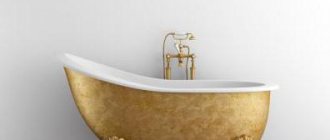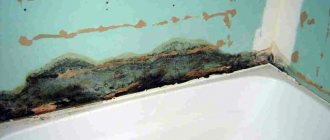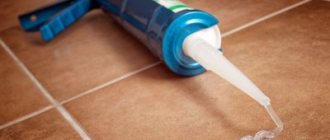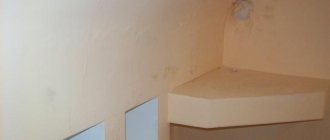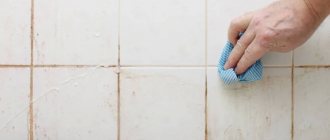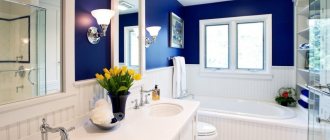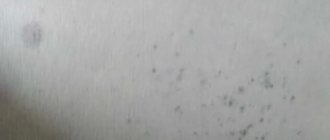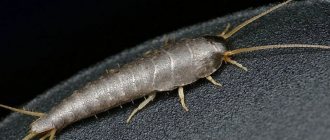Mold has appeared in the bathroom, what should I do? How to get rid of fungus on the ceiling and walls without repair. How to clean the seams between tiles without removing the grout. How often should silicone sealant be changed and why. The best folk remedies according to the site’s editors, as well as practical advice with specific instructions and examples on how to remove black fungus from the bathroom.
Mold in the bathroom cannot be tolerated; the risk to human health is too great. Regular contact with the fungus can lead to severe chronic diseases of the skin and respiratory tract.
The article describes methods on how to get rid of mold in the bathroom tile joints at home.
Causes of mold and mildew
Before you begin removing mold, it is necessary to determine and eliminate the cause of its appearance. Without identifying the routes of penetration and changing the conditions conducive to the development of mold mycelium, even a major renovation of the premises may be ineffective. And after some time, colonies of mushrooms will appear again.
Mold develops in the seams of tiles, on the ceiling, in baseboards, on the surface of sealants and rubber seals of the shower stall. The fungus also affects the enamel bathtub, penetrating under microcracks on its surface. In this case, you will have to restore the bathtub or completely replace it.
The reasons for the appearance of mold in the bathroom are as follows:
- High temperature and humidity, absence of sources of ultraviolet light harmful to mycelium. The humidity in the bathroom after bathing or washing can reach 90%, which leads to the formation of condensation on various surfaces.
- Mechanical damage to wall and ceiling coverings, poor-quality seam sealing. Fungal spores can penetrate into cracks and cracks and multiply in them unhindered.
- Violations committed during construction and repairs. An incorrectly calculated and designed ventilation system does not provide sufficient air exchange and removal of excess moisture. This creates favorable conditions for mold to grow in the bathroom. Incorrectly selected building materials that are not resistant to bathroom conditions are a substrate for the development of fungal mycelium. The ventilation system should consist not only of an exhaust hood, but also an inflow, the role of which is played by the front door. If it is closed, the hood is ineffective.
- Malfunctions in the water supply and sewerage systems. Any leaks contribute to increased humidity in the room.
Why is it dangerous?
Although the word “mold” sounds repulsive, in fact not all its varieties directly threaten health. There are mushrooms that are harmless, but there are those that can lead to destruction of the body and very serious consequences:
- Blue is considered harmless to humans (by the way, it is often used in technologies for preparing gourmet cheeses).
- The gray will not live directly under streams of water. It will prefer to develop at a distance, capturing more and more new territories around the original focus. It is quite difficult to remove it, and at stable humidity (from 70–80% it is almost impossible). The main danger of gray mold is provoking allergic reactions in humans.
- Pink. There is little information about how harmful or safe it is. In any case, it is not recommended to ignore its appearance.
- Green mold actively strives for any favorable environment and the human body is one of such targets. Severe poisoning is one of the key threats. It quickly affects all tissues, and it is very difficult to get rid of the problem (you will probably have to take a lot of antibiotics and other unsafe drugs).
- White does not pose a threat until it enters the body - then damage to internal organs cannot be avoided. Avoid contact with mucor spores through inhalation and skin cuts. Blood is an extremely favorable environment for the life of white mold fungi.
- Some types of black mold cause a dangerous disease in humans and animals - aspergillosis. The pulmonary system is primarily affected. The bronchi are under attack, and in advanced situations there is a threat of leukemia. Other types of black mold attack the gastrointestinal tract. The infected person experiences chronic stool disorder, burning, discomfort, and in critical cases, ulcerative lesions of the mucous membrane.
It is difficult to predict exactly what effect the presence of mold in the bathroom will have on residents: itching on the skin, a long-lasting runny nose for no apparent reason, a cough.
Modern methods of fungus removal
You can also remove fungus in the bathroom using modern technologies. The following effective methods of combating mold are used:
- Ozonation. The method allows you to remove not only visible mold colonies, but also deep-seated spores, including in hard-to-reach places. Ozonation is carried out using professional equipment, so for such processing you will have to call specialists to your home. The procedure lasts 30-60 minutes and will require 2-3 treatments per week (depending on the depth and area of mold damage). Additionally, ozone eliminates odors, disinfects surfaces, and kills insects.
- Destruction of fungus using a household steam cleaner. The device is excellent for removing mold on walls and in tile joints.
- Ionization will effectively help remove fungus in the bathroom. The procedure will require special equipment and a trained worker. The basis of the method is the removal of contaminants with a stream of air enriched with ions. The method allows you to remove old mold in hard-to-reach places, including the seams between tiles. Ionization also has an insecticidal effect. The method is effective, but expensive.
- Microwave. To cleanse fungi, millimeter-frequency emitters are used here, which heat the contaminated surface, which leads to the death of almost all types of mold.
How to deal with mold on curtains
Many housewives are not aware of the existence of harmful fungi on the curtains in the bathroom. Unlike fungus on the walls, mold on a dark curtain is not visible, so the more often you wash the curtain, the higher the chances of avoiding the growth of fungi.
- You can fight moldy fungi that have attacked the curtain with white.
- Using a colorless sponge, apply Whiteness to the moldy spots and wait a couple of minutes.
- When the mold disappears, it is better to rinse the curtain under running water to wash off the whiteness.
- Next, you should wash the curtain in a washing machine or by hand with powder.
- You can remove mold from a curtain using chlorine bleach. Be careful and carefully read the instructions for use. Bleach can not only remove fungal stains, but also ruin the color of the curtain.
Self-cleaning process
It is easiest to remove mold in the bathroom at an early stage of infection, when the number of colonies is small and the fungus has not yet penetrated deeply. In this case, use simple products such as baking soda and vinegar or professional mixtures.
You can use a toothbrush for cleaning, which is especially convenient for removing dirt in the joints between tiles. After cleaning, it is necessary to wash the treated surface with any detergent and wipe dry. To prevent the resumption of growth and spread of fungal colonies, it is important to eliminate the causes that provoke these processes already at this stage.
If the mold has spread and penetrated into the deeper layers, more radical methods will have to be used. At this stage, solutions of chlorine-containing agents, concentrated acetic acid, and a 3% solution of caustic soda are used to clean the tiles. When using these products to prevent burns and vapor poisoning, gloves and a respirator should not be neglected. Moisten the brush in the solution of the selected product and carefully apply it to the stain, leave for 15-30 minutes and rinse with clean water. If necessary, the procedure can be repeated.
If simple and affordable means fail, then professional industrial chemicals will help us solve the problem. They are used strictly according to the instructions and using personal protective equipment.
Which method is better to choose?
The choice of method for removing dirt in the bathroom depends on the area and depth of the lesion. To remove already formed fungal colonies and prevent their reappearance, it is best to use special products. They are not only more effective than the usual bleach or copper sulfate, but also much safer for the consumer and the environment.
If the remedies available for self-use are ineffective, you should seek help from specialists.
If all surface methods for removing contamination do not work, and the mold continues to grow, then you will have to remove the grout between the tiles, plaster and other finishing materials with fungal spores. After this, antifungal treatment with special agents will be required on all accessible surfaces.
Folk remedies
You can remove fungus in the bathroom using folk remedies. For this purpose the following are used:
- Baking soda. Dilute it with water in a 1:1 ratio and rub it into the seams with a brush or treat the surface of the stain. Then wash off with any detergent. Baking soda can also be used to prevent the appearance and eliminate the smell of mold.
- Tea tree essential oil. 2 tsp oils are diluted in 0.5 liters of water and sprayed onto the affected surface.
- Hydrogen peroxide and vinegar. They are used to wipe affected surfaces in pure form or as part of a mixture: 2 parts peroxide, 4 parts water, 1 part boric acid, 2 parts vinegar.
Preventing contamination
When renovating a bathroom, it is important to use materials that are resistant to high temperatures and humidity. Before applying the finishing coating or adhesive tiles, walls and ceilings must be treated with special antifungal compounds.
To prevent the appearance of mold colonies in the bathroom, you must carefully monitor the cleanliness of the room. Regular use of antibacterial and antifungal agents and cleaning surfaces of soap and moisture residues deprive fungal spores of the opportunity to gain a foothold and multiply.
Mold on tiles and ceilings often appears due to condensation. In order to avoid this, it is necessary to establish normal air exchange in the bathroom: an influx of dry air and an exhaust of humid air. To do this, install a fan in the room that operates regardless of lighting.
If there is no inlet shaft, then this problem is solved as follows: a door is used as an inlet. A grille is installed in its lower part, which provides air access regardless of whether the door is open or closed. If ventilation shafts are present, they must be cleaned regularly.
To prevent an increase in humidity, high-quality waterproofing of pipes is necessary. This will protect against condensation forming on them. Regular inspection of the condition of the water supply, plumbing and sewerage systems will prevent the occurrence of leaks. If the bathroom has a wall adjacent to the staircase, it must be insulated or a powerful heated towel rail and heated floor installed.
Safety precautions when treating a room for mold
Any procedures for removing mold from the surface of walls are considered unsafe for health, because spores are easily transferred to human skin and then provoke diseases. In addition, during chemical treatment, caustic alkaline components are used, which also have a negative effect on the condition of the skin.
To protect yourself from harmful effects, it is recommended to use the following:
- durable rubber gloves for hands;
- respirators that protect the respiratory system;
- plastic glasses.
During cleaning, various protective equipment should be used, and upon completion of the process they should be disposed of.
Since during the cleaning process you have to scrape off the dark deposits from the walls with a spatula, dust settles everywhere. Therefore, it is recommended to first remove glasses, hygiene products and other small items from the bathroom. It is better to cover large items with thick oilcloth.
In addition, no strangers, children, or pets should be present in the room during cleaning. After completing the procedure, you should not enter the bathroom for several more hours.
At the same time, we recommend reading the article on the topic - How to clean a toilet from urinary stones, where you will find step-by-step instructions for cleaning the toilet, as well as practical tips for care.
